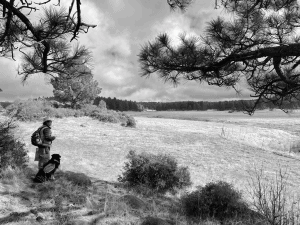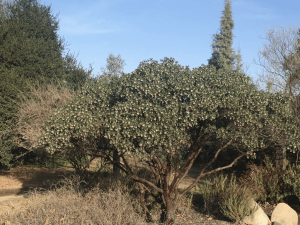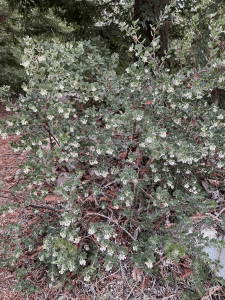February in the Natural Garden 2021
- Posted in: Blog, Monthly Garden Advice
- Tags Seasonal Gardening

Jepson, said something to this effect almost 100 years ago:
“The natural surroundings of Californians are singularly rich and varied. A scientific interest in at least certain features of our natural environment, as for example the trees, shrubs or herbaceous plants, directs one to useful and agreeable intellectual activity. Accurate and detailed knowledge of even a small area lifts the possessor out of the commonplace and enables him directly or indirectly to contribute to the well-being and happiness of his community.”
Willis Linn Jepson, in Preface, Trees of California, 1923
Current events, history, review, and notes
This winter (‘20-’21) started out to be one of the driest on record. Even with the two storms at the end of January, (1.8 inches) we are still well below average with only four inches for the whole season to date, half the amount we had this time last year. Native plants can handle these changes from year to year, but as gardeners we like to make seasonal decisions based on real time weather. We have more of the potential rainy season ahead, so let’s keep our fingers crossed.

Watering
We just got between 1.5 to 2 inches of precipitation. Perfect. Make a mental note how this felt, because it is the ideal amount for the Deep Soak irrigations events you will do this summer. If you regularly read this newsletter, you know what a Deep Soak and a Refreshing Sprinkle are and how we combine these techniques to create an irrigation method ensuring healthy natural gardens. If you would like a review, you can find it here.
There is no need to water an established garden in early February this year. Watch the weather and the forecasts toward the end of the month and always be ready to water new plants anytime, as their roots are not yet reaching into the garden soil. Their nursery root balls can dry out, even when the surrounding soil is moist.
Related to Watering
On my way to work this morning, I passed two (count ‘em 2) white-truck-bright-vest-orange-cone gardening crews, each with trailer rigs for hauling tools. They had every machine imaginable to man for cutting, pruning, shaping, pruning and hacking plants. Leaf blowers, edgers, chainsaws and mowers, plus numerous long handled gardening tools carefully organized. Space for hauling the trimmings. But not one (no not 1) garden hose or soft rain nozzle for hand watering plants. The most basic garden activity. You get the point. They may think that landscapes can make it on autopilot irrigation. Thankfully, you know better.
Pruning
You can still shape your fast growing semi-woody plants such as sage, buckwheat, sunflower, sagebrush, and coyote bush, if you have not done so already. You should thin deciduous trees and shrubs while they are dormant, including stone fruits. However, it is not time to prune most woody native shrubs. Too early for Ceanothus, you’ll cut off flower buds. Manzanitas are flowering, don’t touch them with pruners. Sugarbush are flowering and setting seed. Toyon and lemonade berry are setting up for spring/summer. Fall was your best chance to do any corrective pruning and shaping necessary. Remedial pruning (dead or diseased branches) can be done anytime, but pruning in sync with each plant’s seasonal clock is best.
You should start “pinching” this month. With thumbnail and index finger, clip off the tender new branch tip, less than a half inch. This will encourage side branching on that stem.
Weeding
Keep an eye on anything sprouting from seed. If you sowed wildflower seeds, and they are germinating, it may be difficult to distinguish between the good guys and the bad guys until they mature and flower. But a careful, experienced eye can tell. Study your ground. Year by year you’ll recognize more species in their early stages.
Mulching/Top dress
Leave the mulch layer you applied in fall alone.
Feeding
Let’s talk about fertilizer in March, when the soil is warmer.
Troubleshooting – Varmints, Pests and Diseases
Insect pests are easy to spot this time of year. Watch for scale on the old branches of shrubs like manzanita. If Argentine ants are moving up and down the plant, they are most likely tending their scale farms. Spray with any product containing Neem oil. This organic treatment will smother the scale and is safe for pollinators, hummingbirds, and other species.
Carefully inspect the new growth on manzanita. If you see deformed, curled leaves with bright red blisters, this is caused by a specific pest called manzanita leaf gall aphid.
Control can be difficult. Here is a helpful link:
http://ipm.ucanr.edu/PMG/GARDEN/PLANTS/INVERT/manaph.html
Manzanitas in general
http://ipm.ucanr.edu/PMG/GARDEN/PLANTS/manzanita.html
Be on the lookout for Ceanothus stem gall moth as the plants come into bloom.
http://ipm.ucanr.edu/PMG/GARDEN/PLANTS/INVERT/ceanothusgallmth.html
Ceanothus in general:
http://ipm.ucanr.edu/PMG/GARDEN/PLANTS/ceanothus.html
Other insects:
Always first determine from leaf damage – A. mouthparts, chewing, rasping or sucking. B. Insects present or absent on inspection. More on this next month.
Gophers are really active now. Their ecological benefits in the wild places are hard to comprehend for us gardeners. We don’t like them when they destroy our plants. Here’s another handy link on how to set my favorite trap
https://www.youtube.com/watch?v=ErJspWMTLww
The trick is to always set two traps, pointing in opposite directions in the tunnel. Attach each trap to an above ground stake. Fill in the dirt in front of each trap. The trap’s jaws pierce the pocket gopher right through its top pockets, (think midsection)… adios gopher. You have to put the traps in the main tunnel, not in an exit branch where they simply push soil to the surface. Call or write to me if you have questions. Get good at this and you can skin them to make a little purse.

Annual Wildflowers
Watch the seeds you sowed a couple months ago sprout and grow. It may be too late to sow seeds now. We have plants for you in 4” pots. Come on over.

Adding New Plants
This year, planting should be your main activity for February. Here’s the bullet point instructional:
- Dig the hole twice as wide and half again as deep as the container. Mound the soil to one side.
- Fill the hole with water and wait for it to percolate into the ground.
- Blend organic compost at a ratio 1/3 compost to 2/3 soil that came out of the hole. Include a handful of organic fertilizer. This is now called the amended backfill. Moisten it with a quick sprinkle.
- Place some backfill into the hole and tamp it so that when the root ball is placed in the hole the plant’s collar (where the stem meets the soil) will be slightly higher than the surrounding soil level.
- Remove the plant from the container (turn it upside down and slip it out, never pull on the stem) and place the root ball atop the moist backfill in the bottom of the hole. Be sure the collar is higher than the grade.
- Spill some backfill into the void around the root ball. Lightly sprinkle the whole affair in the process. Moisture is key. No air pockets. Fill to the top of the root ball, moistening all along.
- Create a watering basin by building a mounded ring, well outside the dimensions of the planting hole.
- Detail the area around the plant, the basin, the mound and the surrounding area by hand. My best gardening has been done on my knees.
- Finish by watering the plant, filling the basin. Now the root ball, the backfill, and the surrounding soil are thoroughly soaked.
- Stand back and admire your work. Let’s compare the plant’s main stem to the drain in your sink. Like the drain, the main stem is in the center of the basin, but unlike the drain, the main stem (collar) is NOT in the lowest place of the basin. The collar is emerging from a slight mound, HIGHER than the rest of the basin. Congratulations on using hort sense in your planting

Engage
Everyday is a new day. February can bring fascinating changes in the weather and local conditions on short notice. If you are dedicated to the idea of being outside as much as possible, you will have your gear at the ready; boots, jacket, hat, raincoat, daypack, etc. Your most unforgettable experiences outdoors, on a trail or in your garden, will be those times when you may not feel, at first, perfectly comfortable.
Cold, windy, rainy, wintry days are rare enough in southern California that we should make each one a memorable one. Remember, good gear makes for extreme comfort despite what the elements might throw at you. We’re not climbing Everest here so some basic outdoor clothing will do just fine. In Idaho they say there’s no such thing as cold, just bad gear. But we’re not in Idaho. Go out in the rain and find that the frogs and salamanders are out as well.
All this talk of braving winter weather is nice, but the fact is that at this writing we’re enjoying a sunny 72, so shorts and a tee shirt feel about right.
Let’s hope for some more winter, especially the part about rain.
Hey, we really are makin’ it!
From the February Garden,
Mike Evans
Questions? Help is just one call or one email away. Call (949) 728-0685 or email (with pictures if you like) our special helpline: gardenhelp@californianativeplants.com